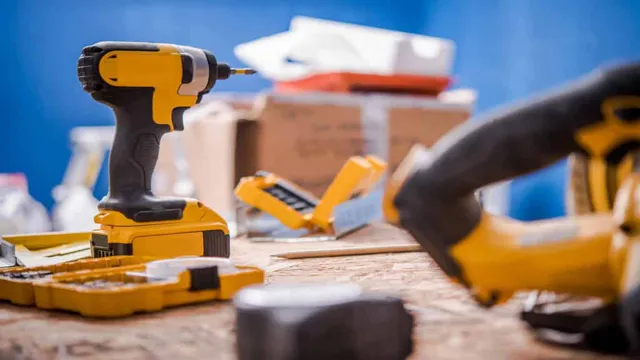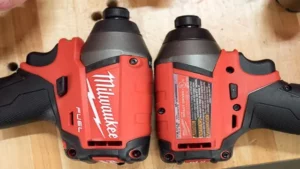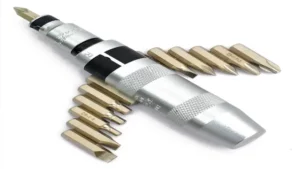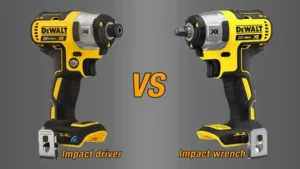If you’re an amateur DIY enthusiast or a professional contractor, you must have come across some tools that seem to blur the line between what they’re designed for and what they can do. One common tool that’s subject to such speculation is the impact driver. With its raw power and unyielding force, it’s a go-to tool for many handymen who need to drive screws in and out of wood, metal, or plastics.
But there’s more to an impact driver than meets the eye. One question that’s been on the minds of many is, “can an impact driver be used as a drill?” In this post, we’ll explore this topic in-depth and uncover some secrets you didn’t know about this versatile tool.
Understanding Impact Drivers and Drills
Many DIY enthusiasts and professionals often wonder if an impact driver can be used as a drill. The short answer is yes, an impact driver can be used as a drill. However, it’s important to keep in mind that impact drivers and drills are designed for different purposes.
Impact drivers are ideal for heavy-duty tasks like screwing in large bolts and driving long screws, while drills are better suited for drilling holes and driving smaller screws. Impact drivers create a powerful rotational force known as “torque” that can cause the drill bit to slip, resulting in damage to the material you are working on. Additionally, impact drivers may not have the precision needed for more delicate tasks.
Overall, while an impact driver can be used as a drill in certain situations, it’s important to use the right tool for the job to ensure safety and precision.
What is an Impact Driver?
An impact driver is a specialized tool designed to deliver high torque output with minimum effort from the user. It works by utilizing a combination of rotational force and rapid concussive blows to drive screws and other fasteners into materials quickly and efficiently. While regular drills rely solely on rotational force and can sometimes struggle with tougher materials, impact drivers excel in situations where extra power is needed.
The bursts of energy generated by an impact driver make it an ideal choice for driving long screws, working with hardwoods and even tougher metals. Think of it like a hammer, where each individual strike may not seem significant, but the cumulative force applied over time results in tremendous impact. With an impact driver, you can expect faster results, better control, and less fatigue on your hands and wrists compared to a traditional drill.
Overall, an impact driver is a valuable addition to any DIY enthusiast or professional craftsman’s toolbox.
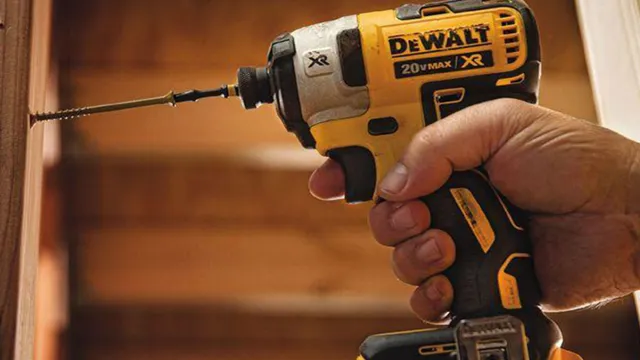
What is a Drill?
A drill is a versatile power tool used for making holes in a variety of materials such as wood, metal, and plastic. It consists of a motor, chuck, and a set of rotating drill bits that bore through surfaces. Drills can be handheld or mounted on a stand and operate using electricity, batteries, or compressed air.
Some drills also come with accessory pieces that can be used for tasks such as sanding, grinding, and polishing. Impact drivers, on the other hand, are similar to drills but are designed to provide high-torque power suitable for driving screws and bolts. They typically have a shorter, more compact design and use a hexagonal chuck for securing bits.
While drills and impact drivers are similar, understanding their differences can help you choose the right tool for the job at hand.
Differences Between Impact Drivers and Drills
One of the most common questions people ask is whether an impact driver can be used as a drill. The answer is yes, an impact driver can be used as a drill, but it may not be the best option for certain tasks. Impact drivers are designed to provide extra torque and speed, making them ideal for driving screws and bolts into tough materials like metal and hardwood.
However, they lack the precision of a drill, making them less suitable for tasks that require a steady and accurate touch. An impact driver’s rotational force and quick bursts of power can also cause the tip to jump and slip, leading to stripped screws and uneven holes. So, while an impact driver can be used as a drill, it’s recommended to use a drill when you need to make accurate and clean holes without damaging the material.
Torque and Speed Differences
Torque and Speed Differences between Impact Drivers and Drills When it comes to power tools, many people may often confuse impact drivers with drills, but there are significant differences between the two. The primary difference between impact drivers and drills is the combination of torque and speed they offer. Impact drivers offer high levels of torque, which is perfect for loosening screws and tightening fasteners.
On the other hand, drills offer higher speed and lower torque, which makes them ideal for drilling holes into wood, metal, and other materials. In a nutshell, impact drivers offer more rotational force while drills offer higher rotational speed. Therefore, it’s essential to choose the right tool for the job you have at hand to get the best results.
Bit Compatibility Differences
When it comes to drilling holes and driving screws, not all tools are created equal. Two of the most popular power tools for DIY enthusiasts and professionals alike are impact drivers and drills. While they may look somewhat similar, these tools are different in many ways.
One key difference is bit compatibility. Drills and impact drivers require different bits due to their mechanical design. Drills require bits with a smooth shank that can fit snugly into the chuck and lock into place with the help of a key or clamp.
On the other hand, impact drivers require hexagonal bits that have a specialized tip designed to withstand the high-torque output of the tool. This important difference means that users must ensure they’re using the correct type of bit for the tool they’re using, or risk damaging both the tool and the material being worked on. By understanding the subtle differences between these two power tools and the bits they require, users can maximize their effectiveness and efficiency, and get the job done right.
When to Use an Impact Driver
If you’re wondering whether you can use an impact driver as a drill, the answer is yes – but it’s not always the best choice. An impact driver is designed to work with screws and bolts, generating a lot of torque to drive them in or out quickly and efficiently. However, it doesn’t have the precision or versatility of a drill, which can work with a variety of materials and bit sizes.
So while you can use an impact driver to make holes with the right bit, it’s not the best tool for the job if you need accuracy, speed, or a clean finish. For example, if you’re drilling into wood, a drill would be better suited since you could adjust the speed to prevent the bit from overheating, giving you a cleaner hole with less tearing. That said, if you need to drill through metal or other tough materials, an impact driver might be the way to go, since its high torque can power through even the thickest materials with ease.
In short, while an impact driver can serve as a drill in a pinch, it’s best to use it for its intended purpose – driving screws and bolts – and leave the drilling to a dedicated drill.
Driving Screws into Wood
As any DIY enthusiast knows, driving screws into wood can be a tricky business. Without the right tools and techniques, you risk damaging the wood, or worse, injuring yourself in the process. When it comes to choosing the right tool for the job, an impact driver can be a real godsend.
But when should you use one? Essentially, an impact driver is designed to deliver high levels of torque with minimum effort. This means it’s perfect for driving long screws into dense or hard materials, such as hardwoods or metal. Compared to a regular drill driver, which can struggle with tougher materials, an impact driver ensures a smoother, more efficient installation.
So, if you’re working on a big project involving lots of heavy-duty screwing, investing in an impact driver could save you a lot of time and effort in the long run.
Loosening Stuck or Corroded Screws
If you’re someone who frequently works with screws, then you’ve most likely come across a stuck or corroded screw at some point. It’s frustrating and time-consuming to try to force it out using your ordinary screwdriver, but that’s where an impact driver can come in handy. An impact driver is a powerful tool that delivers a high-torque force to loosen even the tightest and most stubborn screws without causing any damage to the surrounding material.
It’s especially useful in situations where a bolt or a screw has rusted or seized up and has become impossible to remove with a regular screwdriver. The combination of a high rotational force and a quick, repetitive striking mechanism of an impact driver can create a shockwave that breaks down the corrosion and allows the screw to turn freely. Remember, when you’re dealing with a stuck or corroded screw, an impact driver can save you a lot of time and energy.
So, keep one handy in your tool kit as it’s an excellent solution for loosening stuck screws in no time.
When to Use a Drill
One of the most common questions asked by DIY enthusiasts is whether an impact driver can be used as a drill. The answer is yes, an impact driver can be used as a drill, but it has its limitations. Impact drivers are designed to provide high torque and are ideal for driving screws and fasteners into dense materials.
However, when it comes to drilling holes, impact drivers are not the best choice. This is because impact drivers lack the speed required for drilling and can make the task difficult to execute precisely. If you need to drill large holes or bore through various materials, it is better to use a traditional drill or a hammer drill.
In summary, while an impact driver can be used as a drill, it is not an ideal substitute for a drill when it comes to drilling tasks.
Drilling Holes in Wood, Metal, or Masonry
Drilling holes in wood, metal, or masonry can be a task that requires some knowledge and skills, but it is not rocket science. However, many people wonder when to use a drill and how to choose the right one. For wood, a standard corded or cordless drill is usually sufficient.
For metal, you may need a more powerful drill, such as a hammer drill or an impact driver. And when it comes to masonry, you should consider using a rotary hammer drill. But how do you know which drill fits the job? First, you need to consider the material you will be drilling into, the size of the hole you need, and the depth.
You also need to choose the right bit for the job. For example, a wood bit will not work on metal or masonry, and a masonry bit will not work on wood. Before drilling, prepare the area properly, ensure that the workpiece is securely fastened, and wear appropriate safety gear.
Also, consider the speed and torque of the drill, as well as the drilling method. Different materials require different drilling methods, such as pilot holes or countersinking. In conclusion, drilling holes can be an easy task if you take the time to choose the right tool, bit, and method.
And remember to always prioritize safety when conducting any drilling work.
Conclusion
In conclusion, while an impact driver can technically be used as a drill, it’s not an ideal substitute. Sure, it might get the job done in a pinch, but using a tool for a purpose it wasn’t really designed for is like trying to open a can with a butter knife – it’s not going to be as effective or efficient as using the right tool for the job. So, if you’re looking to bore a bunch of holes in wood or metal, it’s probably best to invest in a good old-fashioned drill.
Save the impact driver for when you need some serious driving power. Trust us, your projects (and your hands) will thank you.
FAQs
What is an impact driver and how does it differ from a drill?
An impact driver is a power tool that delivers high torque output and is used for driving screws and bolts. It differs from a drill in that it has a hammering action that creates bursts of torque, making it more efficient for tasks such as driving long screws and lag bolts.
Can you use an impact driver as a drill?
Yes, an impact driver can be used as a drill, but it’s not recommended for heavy-duty drilling tasks. An impact driver is more suitable for driving screws and bolts, and it may not have the speed and control required for drilling precision holes.
What are some advantages of using an impact driver over a drill?
The advantages of using an impact driver over a drill include its high torque output, which makes it easier and faster to drive screws and bolts, and its compact and lightweight design, which makes it more portable and easier to handle in tight spaces.
What are some disadvantages of using an impact driver over a drill?
The disadvantages of using an impact driver over a drill include its limited versatility, as it’s not recommended for heavy-duty drilling tasks and may not have the speed and control required for drilling precision holes.
Can you use an impact driver to remove screws?
Yes, an impact driver can be used to remove screws, and it’s particularly useful for removing stubborn or rusted screws that are difficult to remove with a regular screwdriver.
What type of bits can be used with an impact driver?
Impact drivers use hexagonal shank bits, which are commonly referred to as hex bits. These bits are designed to fit securely into the chuck of an impact driver and provide increased torque transfer for driving screws and bolts.
What safety precautions should you take when using an impact driver?
When using an impact driver, it’s important to wear eye and ear protection, as the tool can produce loud and high-velocity impacts that can pose a risk of injury. Additionally, you should always follow the manufacturer’s instructions and use the tool in a safe and controlled manner.

